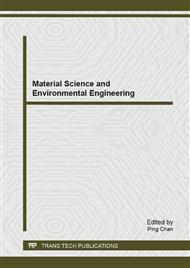[1]
Y. Wei, R.T. Van Houten, A.R. Borger, D.H. Eikelboom, and Y. Fan, Minimization of excess sludge production for biological wastewater treatment, Water Research. 37 (2003) 4453-4467.
DOI: 10.1016/s0043-1354(03)00441-x
Google Scholar
[2]
J. Werther, and T. Ogada, Sewage sludge combustion, Progress in energy and combustion science. 25 (1999) 55-116.
DOI: 10.1016/s0360-1285(98)00020-3
Google Scholar
[3]
T. Mahmood, and A. Elliott, A review of secondary sludge reduction technologies for the pulp and paper industry, Water Research. 40 (2006) 2093-2112.
DOI: 10.1016/j.watres.2006.04.001
Google Scholar
[4]
G. Chen, S. Saby, M. Djafer, and H. Mo, New approaches to minimize excess sludge in activated sludge systems, Water Science & Technology. 44 (2001) 203-208.
DOI: 10.2166/wst.2001.0621
Google Scholar
[5]
J. Wagner, and K. -H. Rosenwinkel, Sludge production in membrane bioreactors under different conditions, Water Science and Technology. (2000) 251-258.
DOI: 10.2166/wst.2000.0655
Google Scholar
[6]
S. Rosenberger, U. Krüger, R. Witzig, W. Manz, U. Szewzyk, and M. Kraume, Performance of a bioreactor with submerged membranes for aerobic treatment of municipal waste water, Water Research. 36 (2002) 413-420.
DOI: 10.1016/s0043-1354(01)00223-8
Google Scholar
[7]
W. Ghyoot, and W. Verstraete, Reduced sludge production in a two-stage membrane-assisted bioreactor, Water Research. 34 (2000) 205-215.
DOI: 10.1016/s0043-1354(99)00138-4
Google Scholar
[8]
S. Yan, K. Miyanaga, X. -H. Xing, and Y. Tanji, Succession of bacterial community and enzymatic activities of activated sludge by heat-treatment for reduction of excess sludge, Biochemical Engineering Journal. 39 (2008) 598-603.
DOI: 10.1016/j.bej.2007.12.002
Google Scholar
[9]
M. Mayhew, and T. Stephenson, Low biomass yield activated sludge: a review, Environmental technology. 18 (1997) 883-892.
DOI: 10.1080/09593331808616607
Google Scholar
[10]
E.W. Low, H.A. Chase, M.G. Milner, and T.P. Curtis, Uncoupling of metabolism to reduce biomass production in the activated sludge process, in Water Research, 2000, pp.3204-3212.
DOI: 10.1016/s0043-1354(99)00364-4
Google Scholar
[11]
Y. Liu, Chemically reduced excess sludge production in the activated sludge process, Chemosphere. 50 (2003) 1-7.
DOI: 10.1016/s0045-6535(02)00551-9
Google Scholar
[12]
G. -H. Chen, H. -K. Mo, S. Saby, W. -K. Yip, and Y. Liu, Minimization of activated sludge production by chemically stimulated energy spilling, Water Science and Technology. (2000) 189-200.
DOI: 10.2166/wst.2000.0269
Google Scholar
[13]
G. -H. Chen, and Y. Liu, Modeling of energy spilling in substrate-sufficient cultures, Journal of Environmental Engineering, 125 (1999) 508-513.
DOI: 10.1061/(asce)0733-9372(1999)125:6(508)
Google Scholar
[14]
S.E. Strand, G.N. Harem, and H.D. Stensel, Activated-sludge yield reduction using chemical uncouplers, Water Environment Research. (1999) 454-458.
DOI: 10.2175/106143097x122013
Google Scholar
[15]
E.W. Low, and H.A. Chase, Reducing production of excess biomass during wastewater treatment, Water Research. 33 (1999) 1119-1132.
DOI: 10.1016/s0043-1354(98)00325-x
Google Scholar
[16]
M. van Loosdrecht, K. Dircks, J. Beun, J. Heijnen, G. -H. Chen, and Y. Liu, Modeling of Energy Spilling in Substrate-Sufficient Cultures, Journal of Environmental Engineering. 126 (2000) 979-980.
DOI: 10.1061/(asce)0733-9372(2000)126:10(979)
Google Scholar
[17]
Y. Liu, and J. -H. Tay, Strategy for minimization of excess sludge production from the activated sludge process, Biotechnology Advances. 19 (2001) 97-107.
DOI: 10.1016/s0734-9750(00)00066-5
Google Scholar
[18]
R.W. Okey, and H.D. Stensel, Uncouplers and activated sludge—the impact on synthesis and respiration, Toxicological & Environmental Chemistry. 40 (1993) 235-254.
DOI: 10.1080/02772249309357946
Google Scholar
[19]
X. -F. Yang, M. -L. Xie, and Y. Liu, Metabolic uncouplers reduce excess sludge production in an activated sludge process, Process Biochemistry. 38 (2003) 1373-1377.
DOI: 10.1016/s0032-9592(03)00019-0
Google Scholar
[20]
C. Aragon, J. Quiroga, and M. Coello, Comparison of four chemical uncouplers for excess sludge reduction, in Environmental technology. 30 (2009) 707-714.
DOI: 10.1080/09593330902894372
Google Scholar
[21]
E.W. Low, and H.A. Chase, The use of chemical uncouplers for reducing biomass production during biodegradation, Water Science and Technology. 37 (1998) 399-402.
DOI: 10.2166/wst.1998.0677
Google Scholar
[22]
M. Mayhew, and T. Stephenson, Biomass yield reduction: Is biochemical manipulation possible without affecting activated sludge process efficiency?, Water Science and Technology. 38 (1998) 137-144.
DOI: 10.2166/wst.1998.0800
Google Scholar
[23]
Y. Tian, J. Zhang, D. Wu, Z. Li, and Y. Cui, Distribution variation of a metabolic uncoupler, 2, 6-dichlorophenol (2, 6-DCP) in long-term sludge culture and their effects on sludge reduction and biological inhibition, Water Research. (2012).
DOI: 10.1016/j.watres.2012.10.008
Google Scholar
[24]
A.P.H. Association, Standard methods for the examination of water and wastewater, American Public Health Association. (1955).
Google Scholar
[25]
J. -H. Kim, X. Guo, and H. -S. Park, Comparison study of the effects of temperature and free ammonia concentration on nitrification and nitrite accumulation, in Process Biochemistry. 43 (2008) 154-160.
DOI: 10.1016/j.procbio.2007.11.005
Google Scholar


